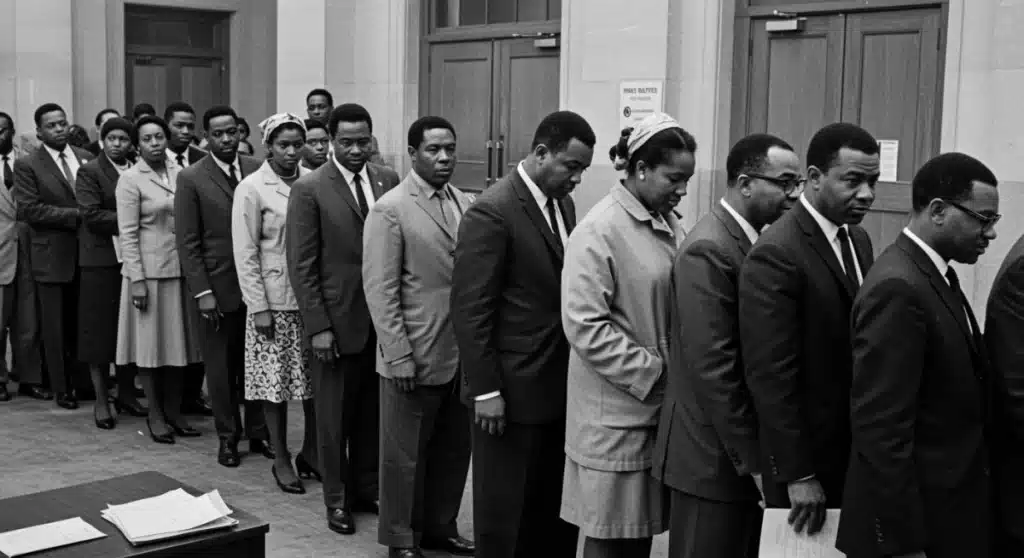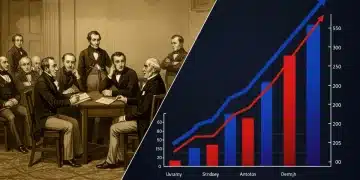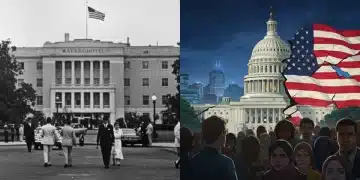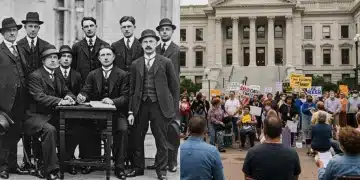1965 Voting Rights Act: Shaping Modern US Elections & 2025 Relevance

How the 1965 Voting Rights Act Shaped Modern US Elections and Its Relevance in 2025 remains a cornerstone of American democracy, fundamentally altering the electoral landscape and continuing to influence political discourse as the nation approaches the 2025 election cycle.
The Genesis of the 1965 Voting Rights Act
The 1965 Voting Rights Act emerged from a period of intense civil rights activism, directly confronting systemic disenfranchisement that had persisted for decades, particularly in the American South. This landmark legislation, signed into law by President Lyndon B. Johnson, aimed to overcome legal barriers at the state and local levels that prevented African Americans from exercising their right to vote guaranteed by the 15th Amendment to the U.S. Constitution. Its passage marked a pivotal moment, shifting the balance of power and initiating a profound transformation in American political participation.
Prior to the Act, various discriminatory practices, including literacy tests, poll taxes, and intimidation tactics, effectively barred millions of citizens from the ballot box. These tactics were widespread, creating an environment where the promise of democracy was denied to a significant portion of the population. The Act’s provisions were designed to dismantle these barriers, ensuring that all eligible citizens, regardless of race, could register and vote free from coercion.
Historical Context and Necessity
The catalytic events leading to the VRA included the brutal Selma to Montgomery marches in Alabama, where peaceful protestors faced violent suppression. These televised events shocked the nation and galvanized public and political will to address racial injustice in voting. The federal government recognized the urgent need for robust legislation to enforce constitutional protections.
- Systemic Disenfranchisement: Decades of state-sanctioned practices prevented minority citizens from voting.
- Civil Rights Movement Pressure: Persistent activism and non-violent protests highlighted the urgency of reform.
- Selma Marches: Violent responses to peaceful protests brought national attention and political momentum.
- Presidential Support: President Johnson’s strong advocacy was crucial for the Act’s passage.
Key Provisions and Immediate Impact on Elections
The 1965 Voting Rights Act introduced several critical provisions that immediately and dramatically reshaped the electoral landscape. Section 2, a nationwide prohibition against voting practices that discriminate on the basis of race, color, or membership in a language minority group, remains a powerful tool. However, perhaps the most impactful original provision was Section 5, which required certain states and local governments with a history of discrimination to obtain federal approval, or ‘preclearance,’ before implementing any changes to their voting laws. This preclearance mechanism was instrumental in preventing new discriminatory practices from emerging.
The immediate impact was profound. Voter registration rates among African Americans surged in states where they had previously been suppressed. This rapid increase in participation led to a significant shift in political representation, with more minority candidates running for and winning public office at all levels of government. The Act also authorized the Attorney General to appoint federal examiners to oversee voter registration and federal observers to monitor elections, ensuring compliance and deterring intimidation.
Transforming Political Representation
The enforcement of the VRA quickly translated into tangible changes in how elections were conducted and who was elected. Areas that had seen virtually no Black elected officials began to elect Black representatives to state legislatures, city councils, and school boards. This newfound political power allowed for the advocacy of policies that better served historically marginalized communities, fundamentally altering the political landscape of the South and beyond.
The Act’s reach extended beyond race, also protecting language minorities. It mandated that voting materials be provided in languages other than English in areas with significant populations of language minority citizens, ensuring broader access to the democratic process. This provision further solidified the Act’s role in promoting inclusive elections.
Evolution and Challenges to the Act Over Time
While the 1965 Voting Rights Act was hailed as a monumental achievement, its journey through American legal and political history has been marked by continuous evolution and significant challenges. The Act has been reauthorized multiple times by Congress, often with overwhelming bipartisan support, underscoring its perceived importance to the nation’s democratic fabric. However, judicial interpretations and political shifts have consistently tested its strength and scope.
A pivotal moment came in 2013 with the Supreme Court’s decision in Shelby County v. Holder. This ruling invalidated Section 4(b) of the Act, which contained the coverage formula used to determine which jurisdictions were subject to Section 5 preclearance. The Court argued that the formula was outdated and no longer reflected current conditions, effectively neutering the preclearance requirement. This decision immediately opened the door for states to enact new voting laws without federal oversight, leading to a wave of changes across the country, including stricter voter ID laws and reductions in early voting periods.
Post-Shelby County Landscape
Following the Shelby County decision, civil rights organizations and voting rights advocates expressed deep concerns about renewed efforts to suppress votes. Many states that were previously covered by Section 5 swiftly implemented new voting regulations. These changes often faced legal challenges under Section 2 of the VRA, which remains intact, but litigation under Section 2 is often more complex and time-consuming than the preventative preclearance process.
- Supreme Court Rulings: Key decisions like Shelby County v. Holder significantly altered the Act’s enforcement.
- Section 5 Invalidated: The preclearance mechanism was removed, impacting federal oversight.
- Rise of New Voting Laws: States previously under preclearance enacted new voter ID, registration, and early voting rules.
- Increased Litigation: Advocates now rely more heavily on costly and lengthy Section 2 lawsuits.
The Act’s Influence on Modern US Elections
Even with the changes to Section 5, the 1965 Voting Rights Act continues to exert significant influence on modern US elections. Section 2 remains a critical tool for challenging discriminatory voting practices. This provision has been used in numerous cases to combat gerrymandering, suppressive voter ID laws, and other barriers to the ballot box. Its existence provides a legal framework for advocates to fight for fair access to voting, even in the absence of preclearance.
The Act also fundamentally shifted the political consciousness around voting rights. It established the principle that voting is a fundamental right that must be protected, a principle that continues to inform debates about election integrity and access. Modern election administration, from voter registration drives to ballot access rules, is constantly measured against the VRA’s legacy of ensuring broad and equitable participation. The demographic shifts in the electorate, partly spurred by the VRA, have also permanently altered political strategies and outcomes.

Current Debates on Voting Access
Today, debates surrounding voting access are often framed by the historical context provided by the VRA. Discussions about automatic voter registration, same-day registration, felon re-enfranchisement, and vote-by-mail are all implicitly or explicitly linked to the Act’s goal of expanding participation. These modern debates reflect ongoing efforts to balance election security with voter access, a tension that the VRA sought to resolve by prioritizing access.
Furthermore, the Act’s legacy influences how political parties target voters and how campaigns are run. The increased diversity of the electorate, a direct result of the VRA, means that candidates must appeal to a broader range of communities. This forces a more inclusive approach to campaigning and policy proposals, fundamentally shaping the nature of political competition in the United States.
Relevance of the Act in the 2025 Electoral Landscape
As the nation looks towards the 2025 electoral landscape, the 1965 Voting Rights Act holds critical relevance. With ongoing debates about election security, voter access, and the integrity of the democratic process, the principles enshrined in the VRA are more pertinent than ever. Legislative efforts to restore and strengthen voting rights protections, often referred to as ‘VRA 2.0,’ are consistently introduced in Congress, highlighting the perceived need for updated federal oversight in a post-Shelby County era.
The 2025 elections will undoubtedly be influenced by current legal challenges to state voting laws, many of which invoke Section 2 of the VRA. These cases will continue to define the boundaries of voter access and the extent to which states can regulate elections without infringing on constitutionally protected voting rights. The outcomes of these legal battles could significantly impact voter turnout and demographic representation in future elections, making the Act a living document in contemporary jurisprudence.
Anticipated Legislative and Judicial Scrutiny
The upcoming year is expected to bring increased legislative and judicial scrutiny to voting rights. Advocates are pushing for federal legislation to re-establish preclearance or introduce new mechanisms to protect voters from discriminatory practices. Simultaneously, state legislatures are likely to continue proposing and enacting new election laws, some of which may face immediate legal challenges under the VRA.
- Federal Reform Attempts: Ongoing efforts to pass new federal voting rights legislation to bolster protections.
- State-Level Legislation: Continued proposals for new voting laws, both expanding and restricting access.
- Section 2 Litigation: Expect more court cases challenging discriminatory practices under the remaining VRA provisions.
- Electoral Outcomes: The strength and enforcement of voting rights will directly influence voter participation and election results in 2025.
Future Outlook: Protecting and Expanding Voting Rights
The future outlook for protecting and expanding voting rights in the United States remains a dynamic and highly contested area, with the legacy of the 1965 Voting Rights Act serving as both a guide and a benchmark. Efforts to modernize and strengthen voting protections are ongoing, driven by a coalition of civil rights groups, legal scholars, and political leaders. The core challenge lies in adapting the VRA’s foundational principles to address contemporary forms of voter suppression, which may be more subtle than the overt tactics of the past.
Technological advancements also present new considerations for voting rights. The rise of online voter registration, electronic voting machines, and cybersecurity concerns all fall within the broader scope of ensuring secure and accessible elections. Any future legislative or judicial interventions will need to grapple with these evolving dynamics, ensuring that the spirit of the VRA—to guarantee equal access to the ballot box for all eligible citizens—is upheld in the 21st century. The 2025 elections will serve as a critical test of these ongoing efforts and the resilience of American democracy.
| Key Point | Brief Description |
|---|---|
| Foundational Impact | Outlawed discriminatory practices, significantly increasing minority voter participation. |
| Shelby County v. Holder | 2013 Supreme Court decision invalidated VRA’s preclearance formula, altering federal oversight. |
| Section 2’s Continued Role | Remains a vital tool for challenging discriminatory voting laws nationwide. |
| 2025 Relevance | Principles continue to shape debates on election integrity, voter access, and legislative reform efforts. |
Frequently Asked Questions About the 1965 Voting Rights Act
The primary goal was to overcome legal barriers at the state and local levels that prevented African Americans from exercising their right to vote, ensuring equal access to the ballot box regardless of race or ethnicity.
The 2013 Supreme Court decision invalidated Section 4(b) of the Act, effectively eliminating the federal preclearance requirement for states with a history of voting discrimination. This significantly altered federal oversight.
Section 2 of the Voting Rights Act remains fully in effect. It prohibits voting practices that discriminate on the basis of race, color, or membership in a language minority group nationwide, allowing for legal challenges.
Its principles continue to frame debates about voter access, election security, and legislative reforms. Ongoing legal challenges under Section 2 and calls for new federal protections highlight its enduring importance for future elections.
Yes, various legislative proposals, such as the John Lewis Voting Rights Advancement Act, have been introduced to restore and strengthen federal oversight of voting laws, though they have not yet passed both chambers.
What Happens Next
The ongoing struggle to protect and expand voting rights, deeply rooted in the legacy of the 1965 Voting Rights Act, will undoubtedly intensify as the United States moves closer to the 2025 electoral cycle. We can anticipate continued legal battles over state voting laws, with Section 2 of the VRA serving as the primary federal mechanism for challenging discriminatory practices. Concurrently, legislative efforts at the federal level to pass new voting rights protections are likely to persist, reflecting a persistent demand for comprehensive reform. These developments will critically shape voter access and participation, influencing the demographic makeup and outcomes of future elections. The political landscape remains fluid, with advocacy groups and policymakers closely monitoring changes and advocating for policies that align with the VRA’s original intent.





